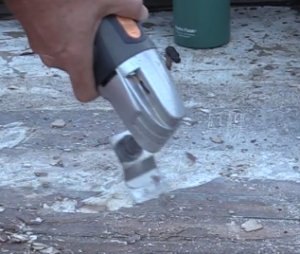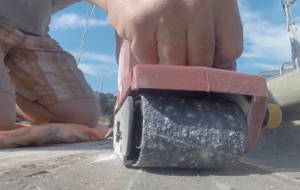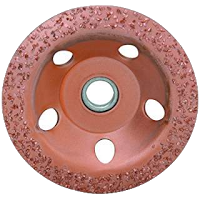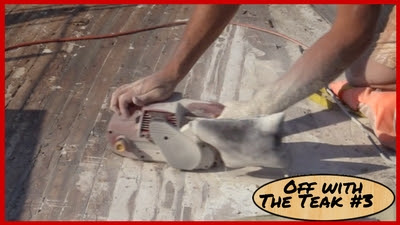We have been continuing on with our teak deck project. It is a lot of work, it is not terribly hard work, it is more mentally challenging in that I am constantly second guessing my approach, what I did, how I did it and all of this is after I planned each step for more time than the step actually takes. I continue to “Mind F$#k” myself every step of the way on this job.
This is one of those topics where everyone has an opinion, and each person I speak to about it, really seems to have a good solid argument that sounds like it may even be based on fact. The down side is that after a while I get tired head and can’t tell if any of it is true or everyone else is just full of it :).
The funny thing is every one has really good intentions, much like I do when I offer up my opinion on how I have done projects on my boat in the past. I have always said to people, I am not an expert, I am just a guy who has done this a few times and I am showing and talking about what worked for me. It may work for you, it may not. But not everyone approaches their discussions the same way, so I often have people state their way of doing things as if is the only way or the absolute correct way.

I do believe that the reality of most situations is that there are circumstances where your known answer may or my not be correct for that situation. With this, I have started to look at other people guidance and opinion as “data points” in my own analysis. When I think of it this way, it helps me feel more comfortable with what I am seeing as I dig deeper into this project and also makes me more comfortable for the possible outcomes. Knowing each of these outcomes (even when 2 different people will provide an answer that is exactly opposite of one another) it at least lets me come to my own conclusion based on what I see.
After removing all the screws, I started to use one of those “multi-tools” like a Fein (only I had a much cheaper brand) to essentially scrape up the thickened epoxy resin that was on top of the fiberglass and below the teak planks. I do truly believe that someone had removed and attempted a repair on this teak deck in the past but may not have prepared the surfaces good as some of this thickened resin was flaking off in some places and rock solid in others.
I worked for about an hour on this and realized this was going to take forever. I worked for about an hour on a section that was about 12″ by 18″ and it was pretty smooth, but was still going to require sanding. I needed a new tactic sooner rather than later. So instead of working to remove the layer of stuff to get it smooth, I opted to remove any spots that were loose or not adhered well and then build up the low spots to meet the high ones.

I knew this stuff was hard, much harder than wood and my orbital palm sanders that I use with 120 and 240 grit sandpaper for my wood working would not be any match for this epoxy resin. I went ahead and picked up an inexpensive belt sander as a way to attempt to remove more material quicker. It worked pretty well. I used 36 grit sandpaper on the belt and it did a good job of knocking the peaks off the surface. It created a lot of dust, even with the bag that was attached to it to catch the sawdust. With sawdust it would likely do a really good job of catching most of it, but with this really fine dust, it filled the bag and also let some of it escape from around it.
Wi th that, it was time to work on a better solution, something a bit more aggressive to just knock down the really high spots and then use the belt sander to smooth it over. I decided to use an angle grinder and remove material that way. I tried a few different solutions.
th that, it was time to work on a better solution, something a bit more aggressive to just knock down the really high spots and then use the belt sander to smooth it over. I decided to use an angle grinder and remove material that way. I tried a few different solutions.
I started with the rubber backed pad and a 36 grit sandpaper and that worked pretty well, it made a little bit more dust for sure, but it worked pretty good and I really liked how it let me get into the spots right along the edge of the mast boot, the dog house and even along the raised lip of the deck compared to the water drain that runs along the toe rail toward the scuppers along the deck. I also used the flap disks which I liked better than the rubber backed pad, but it is a bit more costly. I was also pretty impressed the pads would last for about a 4 to 6 foot area before it was noticeably getting a bit duller and needing to be replaced. Then I found the mother of all great grinding/sanding. This is not a finishing tool, I must first tell you that. It will not get the surface baby’s bottom smooth. But it will remove material quickly and allow you to reduce the amount of time needed with a belt or angle sander down the road. With this tool, I was able to do the work 5-6 times faster than I was when using the belt or disk sanders. I will still have to go over the surface again with the belt sander to get it a bit smoother and I like the belt sander because it has a larger flat surface to get the surface more “fair” before using a very wide fairing trowel with thickened epoxy to get it completely smooth, at which time it will need to be sanded again.
At the bottom of this page below the video is a series of Amazon links to all of the items I referenced and used in this part of the job. In most cases, I have a low cost and higher quality link for each of the power tools and links to the actual accessories I used. Where possible, I attempted to include the links for PRIME items for anyone that has that and can take advantage of the free shipping. These are affiliate links and if you happen to buy something from one of the links, I get a little something. (To tell the you the truth, I don’t know how much as I have never really added the links in the past.)

